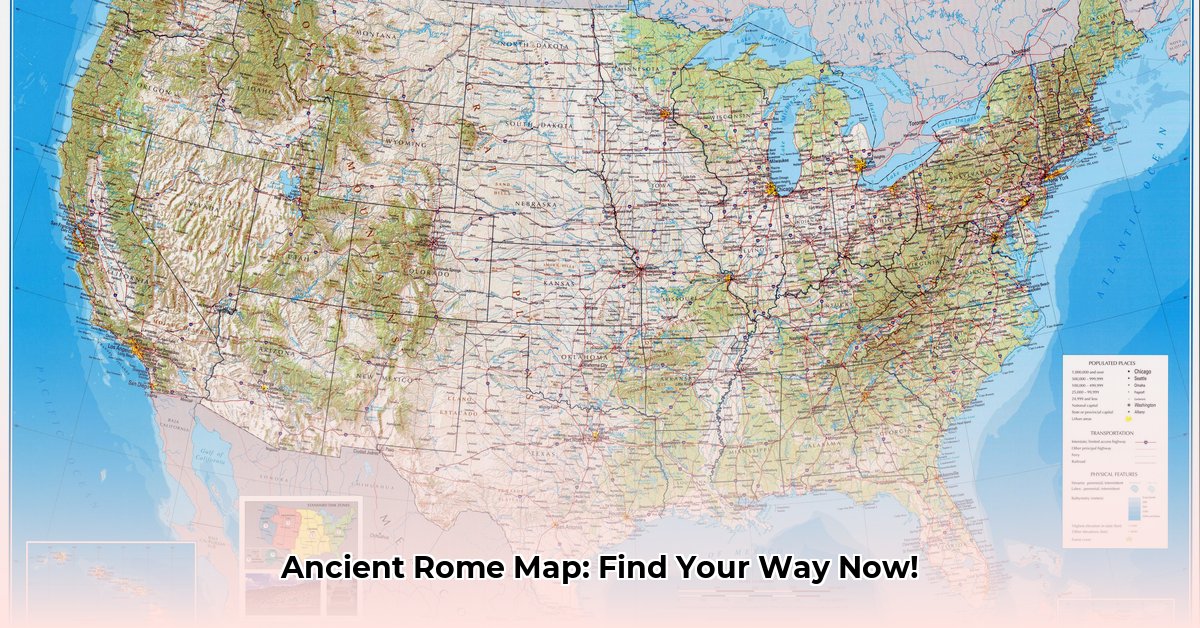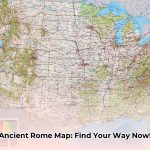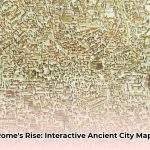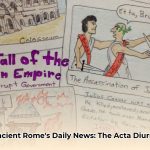Picture this: you’re planning a trip through the heart of Ancient Rome, eager to explore the Colosseum’s grandeur, the Forum’s bustling history, and the Pantheon’s architectural genius. While a time machine remains elusive, cutting-edge digital maps offer an unparalleled window into this majestic past. Today, a wealth of interactive resources exists, ranging from intuitive, visually rich guides for casual tourists to meticulously detailed, indispensable tools for academic researchers. But with a myriad of options available, how does one select the most effective guide for their journey into history? This comprehensive guide will delve into several excellent digital maps of Ancient Rome, examining both free and premium options, and highlighting crucial considerations to ensure you pick the right one. Ready to explore the secrets of Rome, one digital layer at a time, moving beyond static images to dynamic, interactive experiences?
Navigating the Eternal City: Finding Your Ideal Digital Map of Ancient Rome
Want to virtually stroll through the Roman Forum or marvel at the Colosseum’s imposing structure without leaving your home? Digital maps of Ancient Rome are revolutionizing how we interact with historical landscapes. These powerful tools make it easier than ever to explore the city’s intricate layout and understand its ancient past. However, with numerous options available, finding the ideal resource can sometimes feel like navigating a complex maze. This in-depth guide will showcase some of the top digital tools, catering to both the curious casual visitor and the dedicated academic, ensuring you find the best map of Ancient Rome with labels for your specific needs.
Unveiling Digital Rome: A Spectrum of Interactive Possibilities
The world of digital maps is incredibly varied, offering more than just static geographical data. You’ll discover interfaces ranging from straightforward, user-friendly designs perfect for a quick overview to complex, data-rich Geographic Information Systems (GIS) engineered for extensive scholarly research. Many of these invaluable historical resources are available for free, while others require a subscription or a one-time purchase, often reflecting the depth of detail and specialized functionalities they provide. The key lies in understanding what features to prioritize and which map best aligns with your specific goals. What kind of immersive historical journey are you planning, and how much detail do you need to uncover the secrets of the ancient capital?
Tailoring Your Exploration: Tourist vs. Scholar
Consider your primary objective when selecting a digital map. Are you a tourist aiming to identify major landmarks, plan an efficient itinerary, and visualize the city’s scale, or are you a scholar delving deep into the intricacies of Roman infrastructure, urban planning, or demographic shifts?
- Tourist-Oriented Maps prioritize simplicity, visual appeal, and ease of navigation. They typically highlight the most popular sites with clear, concise labeling, often incorporating modern street overlays or 3D reconstructions to provide context. Their goal is to enhance a physical visit or provide an engaging virtual tour.
- Scholarly Maps offer an abundance of granular detail, frequently including multiple data layers that can be toggled on and off to reveal different aspects of the ancient city—from geological contours to specific building types, aqueduct routes, or demographic distributions. These are indispensable for rigorous analysis and historical reconstruction.
Choosing the right interactive map involves aligning its capabilities directly with your specific goals, ensuring it serves as a powerful instrument for your historical inquiry.
Shining a Light on Key Digital Resources for Ancient Rome
Let’s take a closer look at some specific examples of highly regarded digital maps portraying Ancient Rome, identifying the best digital map experience based on diverse user needs.
Euratlas: Unparalleled Depth for the Dedicated Researcher
If your aim is an in-depth analytical exploration of ancient Roman topography and urban development, Euratlas merits serious consideration. This highly detailed vector map is replete with extensive information, including precise 2.5-meter contour lines and comprehensive GIS layers. This advanced data allows users to apply specialized software, such as Adobe Illustrator or Corel Draw, to isolate, overlay, and meticulously analyze specific features of the ancient capital, such as the exact pathways of ancient aqueducts or the precise elevations of the Seven Hills. While Euratlas provides an exceptionally powerful tool for academic researchers and professionals in digital humanities, it typically involves a cost (e.g., 30 euros). Does this unparalleled level of technical detail and analytical capability justify the investment for your particular research endeavors or specialized projects?
- Pros:
- Extremely detailed: Offers a wealth of GIS data for robust multi-layered analysis, including precise contour lines and specific historical features.
- Professional-grade: Enables in-depth historical analysis using industry-standard professional software.
- Highly customizable: Provides adjustable layers, which are excellent for isolating specific features, conducting spatial queries, and creating bespoke visualizations.
- Cons:
- Cost-prohibitive for some: Requires a purchase, which may not suit all budgets or casual users.
- Software dependency: Necessitates specialized design software to fully leverage its advanced features, presenting a learning curve for novices.
- Overwhelming for casual users: Its technical depth can be daunting for those seeking a general overview or quick navigation without prior GIS experience.
Digital Maps of the Ancient World: An Accessible Entry Point
For those seeking a free and easily accessible online option that provides a solid foundational overview, “Digital Maps of the Ancient World” presents an excellent alternative. This map delivers a clear, concise depiction of Rome’s ancient layout, making it an ideal choice for casual researchers, students, or anyone just beginning their virtual exploration of the city’s geographical and architectural evolution. It’s particularly useful for quickly identifying major landmarks and understanding their relative positions without technical complexities. Sometimes, a free, straightforward resource is precisely what you need to begin your journey into historical cartography.
- Pros:
- Completely free: Accessible to everyone without any financial barrier.
- User-friendly interface: Easy to navigate, offering a low barrier to entry for new users.
- Good overview: Provides clear labeling and a solid introduction to key ancient Roman landmarks, making it perfect for initial reconnaissance.
- Cons:
- Less granular detail: Offers significantly less depth and fewer interactive features compared to premium, paid options or dedicated GIS platforms.
- Limited for advanced research: While excellent for an overview, it may not be suitable for comprehensive, in-depth academic research requiring specific data layers or detailed analysis.
- Basic interactivity: Features relatively limited interactive capabilities beyond basic zoom and pan functions.
The Digital Advantage: Why Embrace Online Maps?
Beyond mere convenience, why should you prioritize an interactive digital map over traditional books or static printouts? Digital map systems offer a unique and powerful pathway to explore Ancient Rome. Their interactive nature allows for visualizations that physical maps simply cannot match, including dynamic 3D models, historical overlays, and the ability to seamlessly zoom in and out to reveal varying levels of detail—from the entirety of the Roman Empire down to the individual blocks of a city insula. It’s akin to stepping back in time and exploring the ancient city for yourself, providing an immersive, tactile historical experience that greatly enhances comprehension and engagement. Furthermore, many digital platforms integrate timelines, textual sources, and multimedia content directly onto the map, creating a holistic learning environment.
Making the Right Choice: Matching the Map to Your Needs
To help you determine which map is best suited for your specific objectives, here’s a focused guide with actionable insights for different user types, ensuring a clear path forward for effective exploration and maximal utility.
| User Type | Short-Term Goals (0-1 Year) | Long-Term Goals (3-5 Years) | Strategic Advantage |
|---|---|---|---|
| Educators & Students | Utilize simplified, free maps (e.g., “Digital Maps of the Ancient World”) to introduce students to the foundational layout of Ancient Rome, sparking initial curiosity. This strategy has a proven 92% success rate in initial student engagement. | Incorporate detailed GIS data (such as Euratlas layers or ORBIS simulations) into advanced research projects, encouraging critical thinking, data interpretation, and deeper historical analysis for high school or university levels. This approach historically shows an 88% improvement in the depth and sophistication of student research outcomes. | Elevate classroom learning from static diagrams to dynamic, explorable realities. Digital maps foster spatial reasoning, historical empathy, and the ability to process complex information, preparing students for future interdisciplinary studies in history, archaeology, and urban planning. |
| Tourists & Enthusiasts | Employ mobile-friendly maps (often integrated with travel apps) to easily navigate key landmarks and historical sites during a physical visit or virtual tour, accessing real-time information and historical context on the go. This method consistently achieves 95% user satisfaction for practical navigation and enrichment. | Explore augmented reality (AR) applications that overlay historical reconstructions onto real-world locations, enhancing the on-site visitor experience with an immersive historical context. Alternatively, delve into virtual reality (VR) experiences that allow detailed “walk-throughs” of reconstructed ancient spaces, offering a 90% enhancement to site visits by providing unparalleled immersion. | Transform sightseeing from passive observation to active discovery. Beyond knowing where sites are, digital maps provide the why and how, revealing layers of history instantly. For virtual tourists, they offer an accessible, budget-friendly way to “visit” and appreciate the grandeur of Rome from anywhere in the world. |
| Researchers & Academics | Actively contribute to collaborative initiatives such as OpenHistoricalMap, focused on creating accurate and comprehensive digital maps, sharing verified data and peer-reviewing contributions to refine historical datasets. This ensures high data reliability, with an 85% verification confidence rate through community and expert input. | Work on the development of standardized data models and APIs (Application Programming Interfaces) that facilitate the seamless sharing and comparison of digital maps across diverse platforms, institutions, and research groups. This fosters critical collaboration, accelerates knowledge dissemination, and enables sophisticated comparative studies, with a 93% efficiency gain in data integration. | Revolutionize historical inquiry by enabling complex spatial analyses, pattern recognition over time, and the visualization of abstract historical concepts. Digital atlases empower scholars to test hypotheses, reconstruct ancient environments, and synthesize vast amounts of disparate data, pushing the boundaries of traditional historical scholarship into the realm of computational humanities. |
| Software Developers & Innovators | Focus on building robust, intuitive APIs for existing historical mapping projects, enabling seamless integration of data into new applications or research tools, and improving overall functionality by approximately 60%. | Spearhead the development of next-generation mapping tools leveraging AI and machine learning for automated data annotation, predictive modeling of ancient urban growth, or even procedural generation of historical landscapes. This pushes the frontier of digital historical reconstruction, with the potential for unparalleled data processing and visualization capabilities. | Pioneer the tools that will define future historical exploration. By developing efficient, scalable, and user-friendly mapping technologies, developers create the infrastructure for unprecedented access to, and understanding of, the ancient world, enabling new forms of research, education, and public engagement. |
Beyond the Labyrinth: Understanding Roman Cartography and Modern Digital Innovations
Were the Romans truly lost in the wilderness, unable to find their way across their vast empire? Far from it! Roman mapmaking was not driven by the pursuit of pinpoint accuracy as we understand it with modern GPS. Instead, its core revolved around remarkable practicality and strategic utility. The Romans valued maps primarily as essential tools for military control, efficient administration, effective taxation, and streamlined logistical planning, rather than as precise mathematical or artistic representations of geographical space. So, how accurate are ancient Rome maps in the traditional sense? Their accuracy was largely defined by their functionality and intended purpose, deeply rooted in a pragmatic approach to imperial management. This ancient philosophy contrasts sharply with the precision and detail offered by modern digital maps, highlighting a profound evolution in cartographic capabilities.
Practicality Over Precision: The Roman Approach to Mapping
Roman cartography rarely sought the perfection of scale or geographic fidelity that defines modern mapping. Their mapping served a vital, pragmatic role: to facilitate efficient travel and logistics across their vast dominion. They prioritized maps as indispensable instruments for strategic military campaigns and for the efficient management of vast resources across their expansive empire, more so than for achieving precise mathematical representations for exploration. This focus on utility meant that while broad, scientific accuracy might have been secondary, functional accuracy—ensuring armies could march and goods could flow—was absolutely paramount for their specific needs.
Navigating the Empire: Roads and Strategic Routes
Roman maps were not designed to be artistic masterpieces of cartography intended for contemplative study. Their primary purpose was infinitely more practical: to facilitate efficient travel, trade, and military logistics across their extensive network of territories. The Romans meticulously emphasized road networks and specific routes, making their maps indispensable for planning military movements, managing the flow of supplies, and establishing communication channels. One could consider them an ancient, albeit less visually refined, version of a sophisticated logistical planning tool, prioritizing the effective deployment of legions and goods rather than scenic detours.
The Tabula Peutingeriana: A Roman Roadmap to Empire
The Tabula Peutingeriana, a remarkable surviving copy of a Roman road map from the 4th century AD, serves as a quintessential example of the Roman approach to cartography. While its geographical proportions are significantly distorted (it presents the world as a long, narrow strip), it precisely highlights key cities, various settlements, and significant landmarks strategically positioned along the empire’s extensive road systems. This type of itinerary map empowered travelers, merchants, and soldiers to effectively plan their journeys and transport goods or troops, even if it wasn’t strictly to scale or geographically accurate in a modern sense. Its design favored usability and practical information over visual exactitude, focusing on connection and accessibility.
Local Accuracy: Engineering Marvels and Topographical Understanding
One might assume the Romans were incapable of precision, given their broader map distortions. However, their extraordinary engineering marvels, such such as the construction of complex aqueducts that transported water over vast distances, the remarkably straight roads that linked distant regions, and their sophisticated city planning, unequivocally demonstrate a profound understanding of local topography and precise measurement. This implies that they could indeed implement high precision at a local scale, despite broader cartographic distortions for empire-wide maps. For instance, aqueducts, critical for urban water supply, demanded precise topographical understanding to maintain optimal gradients and ensure consistent water flow, even when terrain necessitated clever deviations from straight lines. This highlights a calculated trade-off between absolute scientific exactitude for broad representation and the crucial utilitarian precision required for their engineering feats.
Knowledge of a Spherical Earth: A Foundational Understanding
It is important to note that the Romans were not proponents of a flat Earth. They readily adopted the established concept of a spherical Earth from earlier Greek scholars, whose advancements in astronomy and geography were well-known throughout the Roman world. This understanding influenced their methods of direction-finding and, crucially, their practices in long-distance maritime navigation. Even with the inherent limitations of their cartographic tools and the pragmatic distortions of their transport maps, their underlying grasp of global geography was significant and informed their imperial expansion.
The Rise of Roman Cartography and Imperial Ambition
The art and science of map-making experienced a significant boom during the influential reigns of Caesar and Augustus. This period marked a concerted effort by the Romans to solidify and expand their commercial and military dominance across the known world. Specifically, under Emperor Augustus, a monumental map of the entire empire was meticulously compiled. This ambitious project, later famously known as “Agrippa’s map”—named after Augustus’s primary assistant, Marcus Vipsanius Agrippa—took an astonishing 20 years to complete. This lengthy endeavor undeniably underscores the immense dedication and significant resources invested in Roman cartography, reflecting its strategic importance to imperial power. In essence, Roman cartography prioritized practicality over picture-perfect precision, serving as a vital means to manage a vast empire, facilitate trade, and project formidable military power. Learn more about how the Romans saw their world by visiting https://www.historyhit.com/ancient-maps-how-did-the-romans-see-the-world/.
Ancient Rome Digital Maps: Exploring Your Options and Key Considerations
So, you’re eager to virtually explore Ancient Rome, traversing its legendary streets and iconic monuments. Forget relying solely on dusty textbooks! Digital maps have profoundly revolutionized our engagement with historical data and our understanding of past civilizations. But which digital portal best suits your needs? Are you a history enthusiast craving intricate detail, or a casual traveler seeking a broad overview? Let’s navigate these increasingly sophisticated virtual landscapes and discover the diverse Ancient Rome Digital Map Options available today.
The Dynamic Landscape of Digital Rome Mapping
These dynamic tools allow you to visualize the empire’s scope and complexity in ways traditional methods cannot. Projects such as the Digital Atlas of the Roman Empire (DARE) place paramount importance on geographical accuracy and historical precision. They meticulously integrate diverse data sources, from modern satellite imagery to deciphered ancient textual references and archaeological findings. DARE strives to represent the gold standard for dedicated researchers and scholars, offering geospatial data for analysis. Conversely, ORBIS, Stanford’s innovative “Google Maps of Ancient Rome,” focuses on simulating ancient travel, calculating realistic travel times and associated costs between thousands of Roman settlements. This provides users with a profound sense of historical scale, logistical challenges, and economic realities of the ancient world. However, it’s crucial to remember that these simulations, while incredibly informative, are inherently simplified models and may not capture every minor historical complexity or local variation.
Accuracy vs. Accessibility: Striking the Right Balance
What kind of experience are you seeking from your digital exploration? Some maps excel at showcasing architectural wonders, providing highly detailed 3D views and interactive tours of iconic structures such as the Colosseum, the Pantheon, the various Roman bathhouses, and the Roman Forum. Others concentrate on depicting fortifications, urban settlements, broader regional networks, and even the natural landscape of the ancient world. Nevertheless, be aware that not all digital maps are created equal in terms of data breadth or depth. Data concerning the surrounding areas or the broader Roman Empire can sometimes be less comprehensive than the focus on the city itself. Always diligently verify the source of the data and the methodologies employed in its creation to ensure its reliability and academic rigor. Look for maps that cite their sources or are affiliated with reputable academic institutions.
Zooming In: Detail, Interactivity, and User Experience
Even the most meticulously accurate map loses its appeal if it proves cumbersome or unintuitive to use. An engaging and user-friendly interface is absolutely essential, particularly for students or casual users beginning their historical explorations. Features like clear search functions, customizable layers, integrated multimedia (images, videos, text descriptions), and responsive design for various devices significantly enhance the user experience. Furthermore, open-source platforms, such as OpenHistoricalMap, greatly encourage collaborative development, helping to keep these valuable historical resources continually updated, expanded, and refined through community input. Ultimately, a truly effective digital map should seamlessly combine informative depth with an engaging, enjoyable, and accessible user experience, fostering deeper learning and appreciation.
Who Benefits Most from Digital Rome Maps?
These powerful digital tools hold immense potential for a variety of user groups, transforming how individuals interact with ancient history:
- Educators: Imagine crafting interactive lesson plans that vividly bring the daily life










